Seven-in-ten Americans view the spread of false information online as a major threat facing the nation in 2025. Many also see terrorism, the condition of the global economy, climate change and the spread of infectious diseases as major threats.
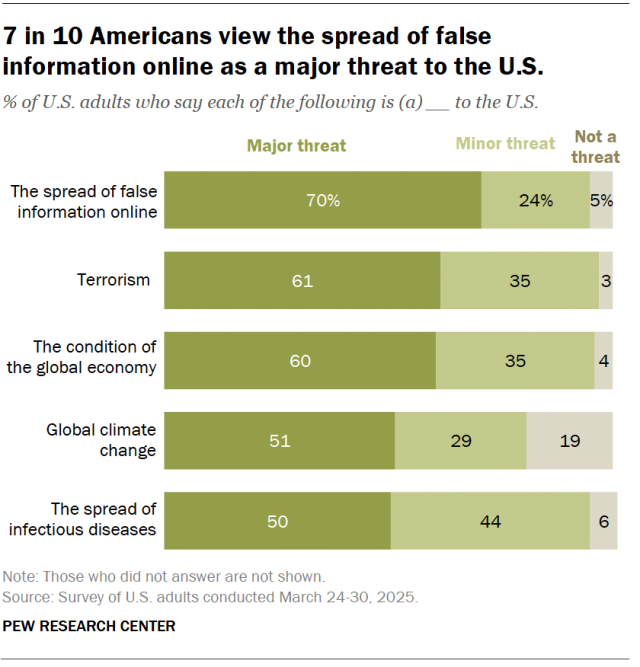
Perceptions of these threats vary by Americans’ party affiliation and age. For example, Democrats and younger Americans are more concerned about climate change than are Republicans and older Americans, while the reverse is true when it comes to terrorism.
Overall, Americans are less likely to see most of these issues as threats today than in the past. But there is a growing partisan divide in concern over global economic conditions. (The survey was conducted before U.S. President Donald Trump announced widespread tariffs in early April.)
These are among the findings of our March survey of 3,605 U.S. adults. For more, read our report on perceptions of global threats across 25 countries.
Views by party
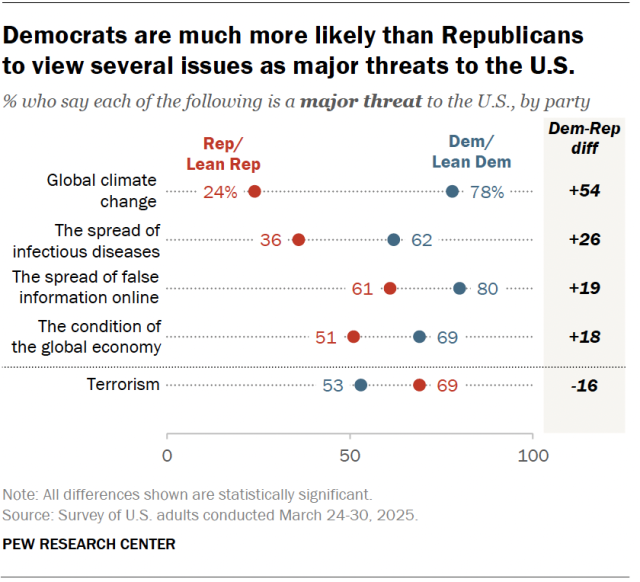
Majorities of Democrats and Democratic-leaning independents view all five issues we asked about as major threats to the nation. Republicans and Republican leaners express less concern than Democrats about each of these issues except terrorism.
The biggest partisan difference is on climate change. Democrats are roughly three times as likely as Republicans to say climate change poses a major threat to the country (78% vs. 24%). Democrats are also much more likely than Republicans to say this about the spread of infectious diseases (+26 percentage points), false information on the internet (+19 points) and the state of the global economy (+18 points).
Republicans, for their part, are 16 points more likely than Democrats to view terrorism as a major threat (69% vs. 53%).
Views by age
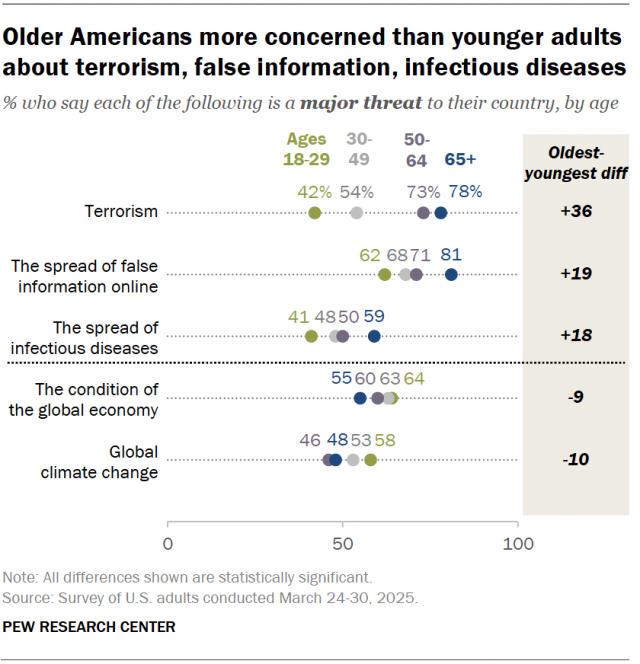
Americans ages 65 and older are more likely than adults under 30 to say terrorism, the spread of false information online and the spread of infectious diseases are major threats to the U.S. The age gap is particularly wide on terrorism: 78% of Americans ages 65 and older view it as a major threat, compared with 42% of adults in the youngest age group.
Younger adults are more likely than their older counterparts to view the condition of the global economy and climate change as major threats. (The same age pattern appeared on climate change in our 2022 survey about global threats.)
Views over time
Americans are less likely today than in 2022 to view most of these issues as major threats to the nation. For example, the share of Americans who say the spread of infectious diseases is a major threat has declined by 7 points since 2022, when the COVID-19 pandemic was still largely regarded as a public health emergency. And the shares of U.S. adults who see global economic conditions and climate change as major threats have also decreased somewhat in the last three years.
The share of Americans who say terrorism is a major threat is down 9 percentage points since the last time we asked this question in 2020, from 70% then to 61% this year.
Partisan views over time
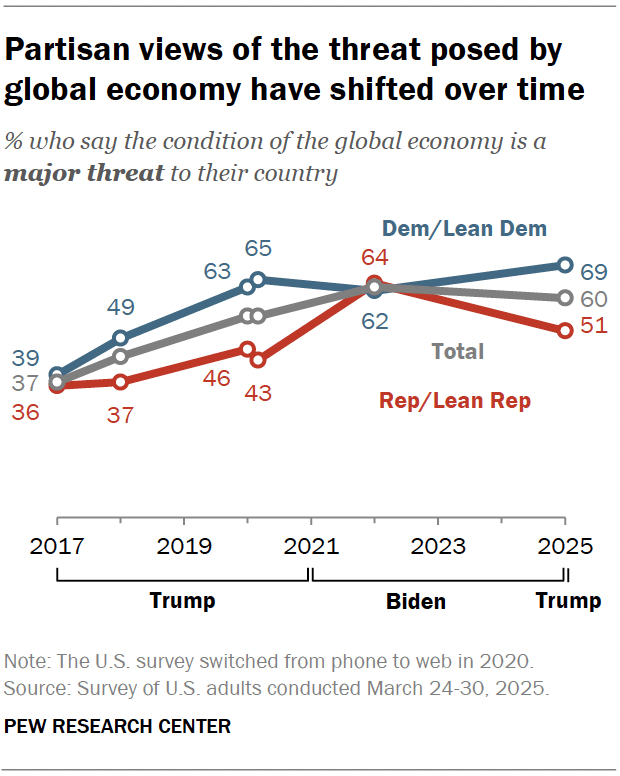
Partisan views have shifted over time on some of the issues included in the survey.
In 2022, during the Biden administration, Democrats and Republicans were about equally likely to see the condition of the global economy as a major threat to the U.S. (62% vs. 64%). As of March 2025, two months into the second Trump administration, Democrats have become more likely – and Republicans less likely – to see global economic conditions as a major threat to the nation. (The survey was conducted before Trump announced widespread tariffs in early April.)
Meanwhile, the gap between Democrats and Republicans on the threat posed by the spread of infectious diseases is shrinking. Partisans on both sides are less likely to call this a major threat today than in 2022.
Views of climate change internationally
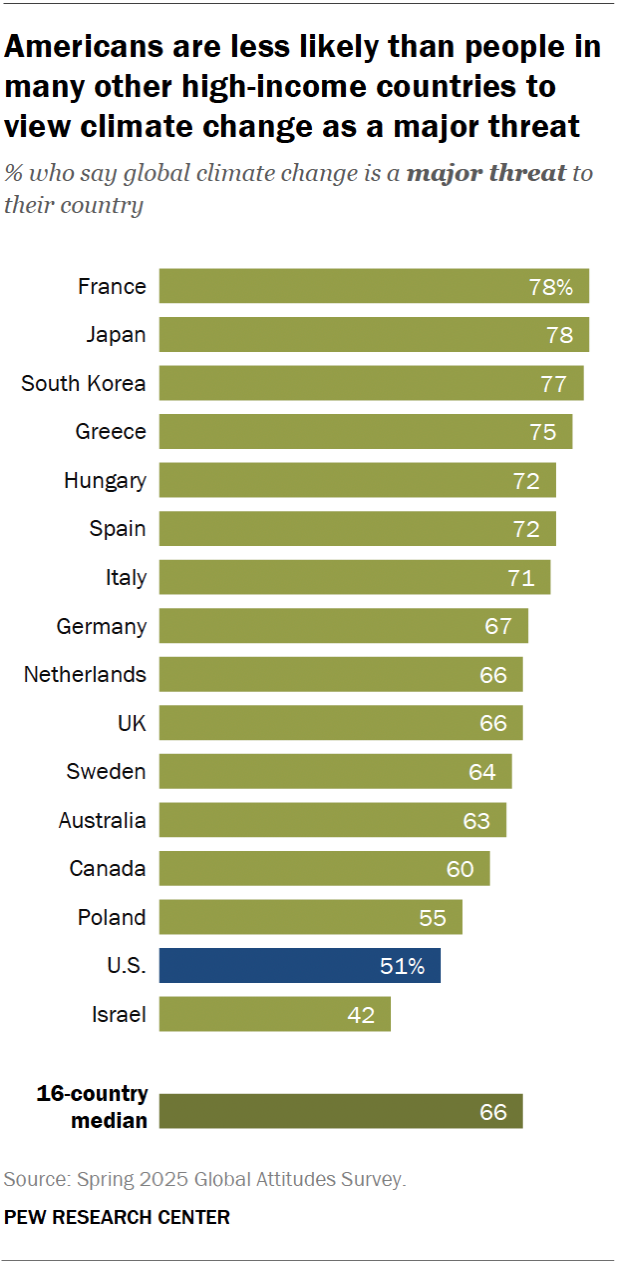
When considering the U.S. in an international context, Americans are less likely than people in most other high-income countries included in the survey to perceive global climate change as a major threat to their country.
A median of 66% adults across the 16 high-income in our survey say climate change is a major threat. In the U.S., 51% express this view. This is lower than in 13 other high-income countries (and statistically tied with Poland).
Americans on the ideological right are especially unlikely to view climate change as a major threat. One-in-five conservatives view it this way – the smallest share among people on the ideological right of any high-income country surveyed.
The share of U.S. adults who say climate change is not a threat (19%) is also higher than the 9% median of adults who say this across the high-income countries in our survey. Americans are more likely than people in almost every other high-income country surveyed to express this view. About four-in-ten U.S. conservatives (42%) say global climate change is not a threat, compared with 9% of moderates and just 2% of liberals.


